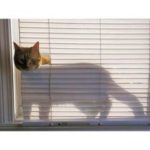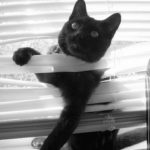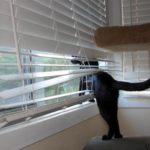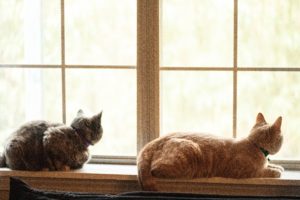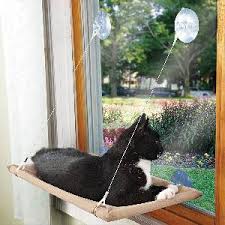
Window Blinds and Cats
Risks of Window Blinds
To your cat’s eye, the dangling end of a drapery or blind cord is an open invitation to play — and possibly to disaster. Even just crawling between drapes or blinds and the window (an all-time favorite feline pastime) can land kitty in a tangle. Cats who get caught in the loops of pull-cords panic. At the very least, the blinds or drapery rod will come down with a crash. At worst, a cat can strangle, do fatal internal damage, or actually get so worked up that his heart gives out.
For maximum safety, tie or wrap all window cords well out of feline reach. Or, even better, avoid vertical blinds, pooling drapery, ornate tassels and long cords that can become strangulation hazards all together.
Safety Suggestions
Allow your cat access to the window without restriction – keep blinds pulled up and cord tied up safely up high away from your cat. Purchase inexpensive safety devices for the blind cords to keep them out of your kitty’s eyesight.
Keep in mind, cats need daily window time for enrichment and sunlight. Thus, it is better to make a window watching perch for your feline friend and make sure it is safe for him.
Ways to Keep Your Cat Out of the Blinds
1. Set up a perch for your cat in front of a window with an unobstructed view (a window without blinds or blinds pulled up and cord safely tied away).
2. Apply double-sided tape to your window sill. Your cat will hate the way it feels on his feet. After a few sticky encounters, he’ll stop visiting that window. (Beware the sticky tape may remove the paint on window sill.)
3. Place a carpet runner, bottom side up, along your window sill. The “spikes” will annoy your cat without hurting her, and she’ll hate the way it feels on her paws more than she likes looking out that window.
Squirt Bottle Does Not Work
The squirt bottle deterrent, in many cat households, has become the popular method for keeping cats off counters, tables and out of windows. It is also the way many people attempt to stop their cats from scratching the furniture, or to stop acting aggressively toward another household member or cat.
You’d think that based on the popularity of the squirt bottle technique, it must be an extremely effective and successful method of training cats. The truth is though, it’s not effective at training a cat to cease engaging in unwanted behaviors. The squirt bottle technique only accomplishes three things:
- It creates frustration in the cat
- It causes the cat to become afraid of you
- The cat learns to wait until you aren’t around before engaging in the behavior
Punishment Doesn’t Work When Training Animals
When you punish a cat for exhibiting a behavior you don’t like, it doesn’t stop the behavior.
- First, it’s important to understand that regardless of how unwanted the behavior is, it serves a purpose for the cat. Your cat isn’t scratching on the sofa or jumping on the counter just to make you mad. Animals engage in behaviors that serve a function (i.e. a pay-off). For example, a cat jumps in the window because she seeks enrichment and warmth (viewing stimulation and sunshine).
- Additionally, many of the behaviors cat parents view as unwanted, such as furniture scratching, are normal, natural behaviors. When you squirt the cat with water for scratching the furniture you may momentarily stop the behavior but the cat has a normal and natural need to scratch. If he gets punished every time he attempts to engage in a normal behavior, he will probably become afraid of you and he’ll also continue the behavior in secret. That’s a very stressful combination for your feline friend.

